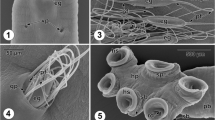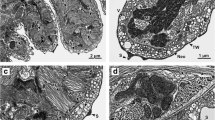Abstract
This paper includes the first transmission electron microscopical (TEM) study of the tegument of a member of the basal digenean family Aporocotylidae. Scanning electron microscopical investigations of the fish blood fluke Aporocotyle simplex show that each boss on the lateral body surface bears 12–15 simple, uniform spines which extend from 0.5–2.7 μm above the surface of the boss. TEM observations revealed that these spines reach deep beneath the distal cytoplasm of the tegument for much of their length (9–12 μm) and are surrounded by a complex of diagonal muscles in each boss. This is the first record of any digenean with so-called ‘sunken’ spines. The results suggest that aporocotylid spines arise from within the sarcoplasm of the boss diagonal muscles. The sunken cell bodies (perikarya) of the tegument are connected to the distal cytoplasm via ducts (specialised processes lined by microtubules); this in contrast to other digeneans studied, where they are connected via non-specialised cytoplasmic processes. Within the distal cytoplasm, the tegumental ducts of A. simplex are surrounded by invaginations of the basal membrane and release their cytoplasmic inclusions into the distal cytoplasm. These apparently unique morphological features of the tegument, especially the deep origin of the spines, may represent useful characteristics for understanding aporocotylid relationships, especially in view of the known variation in the spine patterns of aporocotylids.




Similar content being viewed by others
References
Abbas MK, Cain GD (1987) Actin and intermediate-sized filaments of the spines and cytoskeleton of Schistosoma mansoni. Parasitol Res 73:66–74. https://doi.org/10.1007/bf00536338
Abdul-Salam J, Sreelatha BNS (1992) The surface topography and ultrastructure of the tegument of the ectoparasitic digenean Transversotrema licinum. Zool Anz 228:248–261
Antonelli L, Quilichini Y, Foata J, Marchand B (2014) Topography and ultrastructure of the tegument of Aphallas tubarium (Rudolphi, 1819) Poche, 1926 (Digenea: Cryptogonimidae), intestinal parasite of the common Dentex dentex (Linnaeus, 1758) from Valinco Gulf. Acta Parasitol 59:615–624. https://doi.org/10.2478/s11686-014-0281-8
Bullard SA, Overstreet RM (2008) Digeneans as enemies of fishes. In: Eiras JC, Segner H, Wahli T, Kapoor BG (eds) Fish diseases, Chapter 14, vol 2. Science Publishers, Enfield, New Hampshire, pp 817–976
Bullard SA, Snyder SD, Jensen K, Overstreet RM (2008) New genus and species of Aporocotylidae (Digenea) from a basal actinopterygian, the American paddlefish, Polyodon spathula (Acipenseriformes: Polyodontidae) from the Mississippi delta. J Parasitol 94:487–495. https://doi.org/10.1645/ge-1323.1
Bullard SA, Williams EH, Bunkley-Williams L (2012) New genus and species of fish blood fluke (Digenea: Aporocotylidae Odhner, 1912) from stoplight parrotfish, Sparisoma viride (Bonnaterre, 1788) (Labridae: Scarinae) in the Caribbean Sea. J Parasitol 98:1139–1143. https://doi.org/10.1645/GE-3099.1
Clegg JA (1972) The schistosome surface in relation to parasitism. In: Taylor AER, Muller R (eds) Functional aspects of parasite surfaces, vol 10. Symposia of the British Society for Parasitology, Blackwell Scientific Publications, Oxford, pp 23–40
Cohen C, Reinhard B, Castellani B, Norton P, Stirewalt M (1982) Schistosome surface spines are ‘crystals’ of actin. J Cell Biol 95:987–988. https://doi.org/10.1083/jcb.95.3.987
Cohen SC, Kohn A, Fatima Diniz Baptista-Farias M (2001) Ultrastructure of the tegument of Saccocoelioides godoyi. J Helminthol 75:15–21. https://doi.org/10.1079/joh200040
Conn DB, Goater CP, Bray D (2008) Developmental and functional ultrastructure of Ornithodiplostomum ptychocheilus diplostomula (Trematoda: Strigeoidea) during invasion of the brain of the fish intermediate host, Pimephales promelas. J Parasitol 94:635–642. https://doi.org/10.1645/ge-1421r.1
Cribb TH, Chick RC, O’Connor W, O’Connor S, Johnson D, Sewell KB, Cutmore SC (2017) Evidence that blood flukes (Trematoda: Aporocotylidae) of chondrichthyans infect bivalves as intermediate hosts: indications of an ancient diversification of the Schistosomatoidea. Int J Parasitol 47:885–891. https://doi.org/10.1016/j.ijpara.2017.05.008
Erasmus DA (1967) The host-parasite interface of Cyathocotyle bushiensis Khan, 1962 (Trematoda: Strigeoidea). II Electron microscope studies of the tegument J Parasitol 53:703–704. https://doi.org/10.2307/3276757
Erasmus DA (1970) The host-parasite interface of strigeoid trematodes. IX. A probe and transmission electron microscope study of the tegument of Diplostomum phoxini Faust, 1918. Parasitology 61:35–41. https://doi.org/10.1017/s0031182000040828
Filippi J-J, Quilichini Y, Marchand B (2013) Topography and ultrastructure of the tegument of Deropristis inflata Molin, 1859 (Digenea: Deropristidae), a parasite of the European eel Anguilla anguilla (Osteichthyes: Anguillidae). Parasitol Res 112:517–528. https://doi.org/10.1007/s00436-012-3162-9
Fujino T, Ishii Y, Choi DW (1979) Surface ultrastructure of the tegument of Clonorchis sinensis newly excysted juveniles and adult worms. J Parasitol 65:579–590. https://doi.org/10.2307/3280325
Fukuda K, Fujino T, Hirata M (1987) Ultrastructural characterization of tegumental spines of the adult lung fluke, Paragonimus westermani. Parasitol Res 73:95–97. https://doi.org/10.1007/bf00536342
Gibson DI (1996) Trematoda. In: Margolis L, Kabata Z (eds) Guide to the parasites of fishes of Canada. Part IV, Canadian Special Publication of Fisheries and Aquatic Sciences No. 124. NRC Press, 373 pp, Ottawa. https://doi.org/10.1139/9780660164038
Gobert GN, Stezel DJ, McManus DP, Jones MK (2003) The ultrastructural architecture of the adult Schistosoma japonicum tegument. Int J Parasitol 33:1561–1575. https://doi.org/10.1016/s0020-7519(03)00255-8
Grano-Maldonado MI, Bruno de Sousa C, Roriquez-Santiago M (2018) First insights into the ultrastructure of myosin and actin bands using transmission electron microscopy in Gyrodactylus (Monogenea). J Microsc Ultrastruct 27:177–181. https://doi.org/10.1016/j.jmau.2017.07.002
Hockley DJ (1973) Ultrastructure of the tegument of Schistosoma. Adv Parasitol 11:233–305. https://doi.org/10.1016/s0065-308x(08)60188-8
Jamjoon MB, Shalaby I (2006) The contribution of electron microscope studies to the taxonomy and biology of parasitic trematodes. World J Zool 1:64–81
Justine J-L, Poddubnaya LG (2018) Spermiogenesis and spermatozoon ultrastructure in basal polyopisthocotylean monogeneans, Hexabothriidae and Chimaericolidae, and their significance for the phylogeny of the Monogenea. Parasite 25:7. https://doi.org/10.1051/parasite/2018007
Køie M (1982) The redia, cercaria and early stages of Aporocotyle simplex Odhner, 1900 (Sanguinicolidae) – a digenetic trematode which has a polychaete annelid as the only intermediate host. Ophelia 21:115–145. https://doi.org/10.1080/00785326.1982.10426582
McCullogh JS, Fairweather I (1989) The fine structure and possible functions of scolex gland cells in Trilocularia acanthiaevulgaris (Cestoda, Tetraphyllidea). Parasitol Res 75:575–582. https://doi.org/10.1007/bf00931169
McMichael-Phillips DF, Lewis JW, Thorndyke MC (1992) Ultrastructure of the egg of Sanguinicola inermis Plehn, 1905 (Digenea: Sanguinicolidae). J Nat Hist 26:895–904. https://doi.org/10.1080/00222939200177054
McMichael-Phillips DF, Lewis JW, Thorndyke MC (1994) Ultrastructure of the digestive system of the cercaria of Sanguinicola inermis Plehn, 1905 (Digenea: Sanguinicolidae). Syst Parasitol 29:1–12. https://doi.org/10.1007/bf00009834
Morris GP, Threadgold LT (1968) Ultrastructure of the tegument of adult Schistosoma mansoni. J Parasitol 54:15–27. https://doi.org/10.2307/3276867
Nolan MJ, Cribb TH (2004) Ankistromeces mariae n. g., n. sp. (Digenea: Sanguinicolidae) from Meuschenia freycineti (Monacanthidae) off Tasmania. Syst Parasitol 57:151–157. https://doi.org/10.1023/b:sypa.0000013860.96907.98
Nolan MJ, Cribb TH (2006) An exceptionally rich complex of Sanguinicolidae von Graff, 1907 (Platyhelminthes: Trematoda) from Siganidae, Labridae and Mullidae (Teleostei: Perciformes) from the Indo-West Pacific Region. Zootaxa 1218:1–80
Olson PD, Cribb TH, Tkach VV, Bray RA, Littlewood DTJ (2003) Phylogeny and classification of the Digenea (Platyhelminthes: Trematoda). Int J Parasitol 33:733–755. https://doi.org/10.1016/s0020-7519(03)00049-3
Orélis-Ribeiro R, Ruiz CF, Curran SS, Bullard SA (2013) Blood flukes (Digenea: Aporocotylidae) of epipelagic lamniforms: redescription of Hyperandrotrema cetorhini from basking shark (Cetorhinus maximus) and description of a new congener from shortfin mako shark (Isurus oxyrinchus) off Alabama. J Parasitol 99:835–846. https://doi.org/10.1645/12-125.1
Orélis-Ribeiro R, Arias CR, Halanych KM, Cribb TH, Bullard SA (2014) Chapter one – diversity and ancestry of flatworms infecting blood of nontetrapod craniates “Fishes”. Adv Parasitol 85:1–64. https://doi.org/10.1016/B978-0-12-800182-0.00001-5Orélis-Ribeiro
Pappas PW, Read CP (1975) Membrane transport in helminth parasites: a review. Exp Parasitol 37:469–530. https://doi.org/10.1016/0014-4894(75)90016-8
Poddubnaya LG, Mishina E, Zhokhov AE, Gibson DI (2010) Ultrastructural features of the tegumental surface of a new metacercaria, Nematostrigea sp. (Trematoda: Strigeidae), with a search for potential taxonomically informative characters. Syst Parasitol 75:59–73. https://doi.org/10.1007/s11230-009-9207-5
Poddubnaya LG, Reed C, Gibson DI (2015) The surface topography of Callorhychocotyle callorhynchi (Manter, 1955) (Monogenea: Hexabothriidae), a parasite of the holocephalan fish Callorhinchus capensis. Parasitol Res 114:3393–3399. https://doi.org/10.1007/s00436-015-4565-1
Poddubnaya LG, Hemmingsen W, Gibson DI (2017) The unique uterine structure of the basal monogenean Chimaericola leptogaster (Monogenea: Polyopisthocotylea), an ectoparasite of the relictual holocephalan fish Chimaera monstrosa. Parasit Res 116:2695–2705. https://doi.org/10.1007/s00436-017-5578-8
Podvyaznaya IM (1999) The fine structure of the tegument of cercariae and developing metacercariae of Diplostomum chromatophorum (Trematoda: Diplostomidae). Parazitologiya 33:507–519 (In Russian)
Reger JF (1976) Studies on the fine structure of cercarial tail muscle of Schistosoma sp. (Trematoda). J Ultrastruct Res 57:77–86. https://doi.org/10.1016/s0022-5320(76)80057-3
Rieger RM, Tyler S, Smith JPS, Rieger GE (1991) Platyhelminthes: Turbellaria. In: Harrison FW, Bogitsh BJ (eds) Microscopic anatomy of invertebrates, Platyhelminthes and Nemertinea, vol 3. Wiley-Liss, New York, pp 7–140
Ruiz CF, Curran SS, Bullard SA (2013) Blood flukes (Digenea: Aporocotylidae) of epipelagic lamniforms: redescription of Hyperandrotrema cetorhini from basking shark (Cetorhinus maximus) and redescription of a new congener from shortfin mako shark (Isurus oxyrinchus) off Alabama. J. Parasitol 99:835–846. https://doi.org/10.1645/12-125.1
Scholz T, Ditrich O, Tuma M, Giboda M (1991) Study of the body surface of Haplorchis yokogawai (Katsuta, 1932) and H. taichui (Nishigori, 1924). Southeast Asian J Trop Med Public Health 22:443–448
Sharma PN, Rai N, Brennan GP (1996) Ultrastructure of the tegument of the trematode Ganeo tigrinum, parasitizing the intestine of Indian frogs. J Helminthol 70:137–142. https://doi.org/10.1017/s0022149x00015297
Smith JW (2002) Family Sanguinicolidae von Graff, 1907. In: Gibson DI, Jones A, Bray RA (eds) Keys to the Trematoda, vol 1. CAB International and the Natural History Museum, Wallingford, pp 433–452
Sobhon P, Upatham ES, McLaren DJ (1984) Topography and ultrastructure of the tegument of adult Schistosoma mekongi. Parasitology 89:511–521. https://doi.org/10.1017/s0031182000056730
Stitt AW, Fairweather I, Trudgett AG, Johnston CF, Anderson SML (1992) Localization of actin in the liver fluke, Fasciola hepatica. Parasitol Res 78:96–102. https://doi.org/10.1007/bf00931648
Sulbarán G, Alamo L, Pinto A, Marquez G, Méndez F, Padrón R, Craig R (2015) An invertebrate smooth muscle with striated muscle myosin filaments. PNAS 112(42):E5660–E5668. https://doi.org/10.1016/j.bpj.2013.11.911
Świderski Z, Montoliu I, Feliu C, Gibson DI, Miquel J (2013) A transmission electron microscopical study of the tegument of Maritrema feliui (Digenea: Microphallidae). Acta Parasitol 58:478–485. https://doi.org/10.2478/s11686-013-0161-7
Threadgold LT (1967) Electron microscope studies of Fasciola hepatica. III. Further observations on the tegument and associated structures. Parasitology 75:633–637. https://doi.org/10.1017/s0031182000073108
Thulin J (1980a) A redescription of the fish blood-fluke Aporocotyle simplex Odhner, 1900 (Digenea, Sanguinicolidae) with comments on its biology. Sarsia 65:35–48. https://doi.org/10.1080/00364827.1980.10431470
Thulin J (1980b) Scanning electron microscope observations of Aporocotyle simplex Odhner, 1900 (Digenea: Sanguinicolidae). Z Parasitenkd 63:7–32. https://doi.org/10.1007/bf00927723
Thulin J (1982) Structure and function of the female reproductive ducts of the fish blood-fluke Aporocotyle simplex Odhner, 1900 (Digenea: Sanguinicolidae). Sarsia 67:227–248. https://doi.org/10.1080/00364827.1982.10421338
WoRMS (2019) Aporocotylidae Odhner, 1912. Accessed at: http://www.marinespecies.org/aphia.php?p=taxdetails&id=414763 on 2019-02-12
Žd’arská Z, Soboleva TN, Valkounova J, Sterba J (1990) Ultrastructure of the general body tegument of the trematode Brachylaimus aequans. Helminthologia 27:3–9
Acknowledgements
The authors would like to thank the staff of the RV ‘Johan Ruud’, belonging to Tromsø University (Norway), for their help with the fishing during June 2017. We are also grateful to Master’s students, Ben Hall and Jonathon McFall (University of Aberdeen, Scotland), for their help with dissection of the fishes and the collection of parasites at sea. Our thanks are due to the staff of the Centre of Electron Microscopy, I.D. Papanin Institute for the Biology of Inland Waters (Borok, Russia) for technical assistance. The present study was carried out within the framework of a state assignment of the Federal Agency for Scientific Organizations, Russia (theme No. AAAA-A18-118012690100-5) to LP.
Author information
Authors and Affiliations
Corresponding author
Ethics declarations
This study was conducted in compliance with all institutional, national, and international guidelines on the care and use of animals.
Conflict of interest
The authors declare that they have no conflict of interest.
Additional information
Section Editor: Stephen A. Bullard
Publisher’s note
Springer Nature remains neutral with regard to jurisdictional claims in published maps and institutional affiliations.
Rights and permissions
About this article
Cite this article
Poddubnaya, L.G., Hemmingsen, W., Poddubny, S.A. et al. Unique ultrastructural characteristics of the tegument of the digenean blood fluke Aporocotyle simplex Odhner, 1900 (Digenea: Aporocotylidae), a parasite of flatfishes. Parasitol Res 118, 2801–2810 (2019). https://doi.org/10.1007/s00436-019-06436-1
Received:
Accepted:
Published:
Issue Date:
DOI: https://doi.org/10.1007/s00436-019-06436-1




